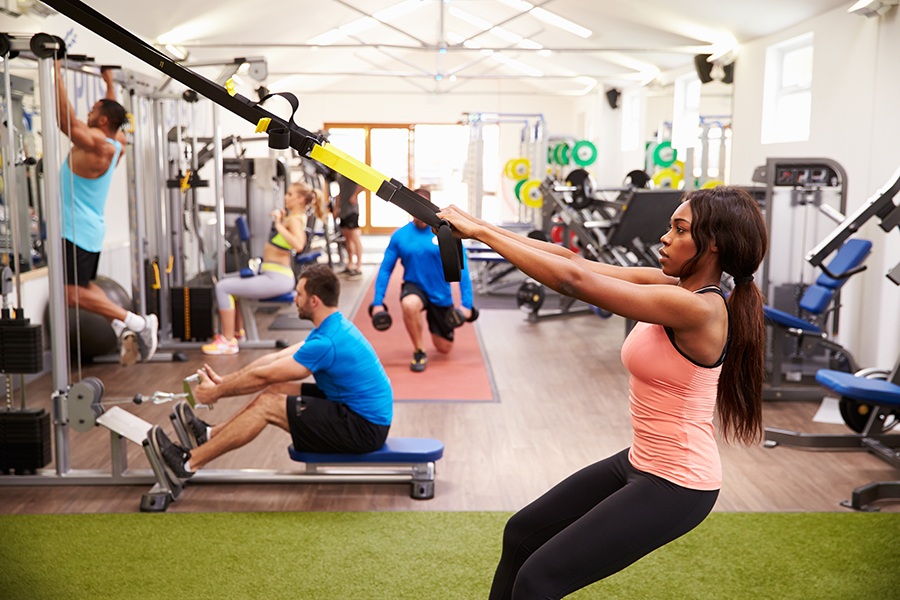How to Create the Best Full Body Strength Training Program
Follow this simple guide, complete with two sample workouts, and you'll always know what to do when you walk into the gym.

Photo via Getty Images/monkeybusinessimages
As a strength coach I get many questions, from “How much protein should I eat in a day?” to “What’s the proper way to engage my core?” One of the most frequent questions I get, and the main reason people work with me (or any trainer), is “What exercises should I be doing when I go to the gym?” It’s hard to know where to begin, and it’s definitely way easier to head straight to the treadmill. But your return on investment will be far greater if you work your body from all angles, with weights.
So, to address this common conundrum here is my formula for creating a perfect (and different) full body workout routine every time you hit the gym.
To begin, you must first understand the five basic human movements used throughout the workout routine or program: squat, hinge, push, pull, and heavy carries (other trainers will have different variations on the same theme). A perfect full body workout routine will include each of these things. In addition to these five are also rotation and anti-rotation exercises as well as what we call locomotion movements (walking, running, crawling, etc.) and plyometrics (jumping, skipping, etc.).
Some examples of different exercise variations of these movements include:
Squat: Goblet squat, back squat, front squat, single leg squat, zercher squat, overhead squat, split squat
Hinge: Conventional deadlift, sumo deadlift, Romanian deadlift, single-leg deadlift, single-leg Romanian deadlift, stiff leg deadlift, KB swings
Push: Dumbbell bench press, barbell bench press, single-arm bench press, cable press, dumbbell fly, push-ups, step-up
Pull: Dumbbell row, barbell row, single-arm dumbbell row, seated cable row, TRX row, chin up, lat pull down
Heavy carries: Farmer’s carry, overhead waiter’s carry, suitcase carry, front rack carry, goblet carry, kettlebell bottom’s up carry
Rotation exercises: Russian twists, medicine ball rotational slams, cable wood chop
Anti-rotation exercises: Side plank, Pallof press, anti-rotation chop, any single arm or leg work
There are some deviations to these categories and certain exercises that don’t necessarily fit, like glute bridges and lunges, which I substitute for hinges and single leg exercises in some instances. Plyometrics and locomotion exercises are incorporated into the end of the workout in what I call a “finisher” to really push the client to use whatever they have left in the tank. Finisher exercises include things like: sled pushes, burpees, bear crawls, battle ropes, low box runner, rowing intervals, agility ladder, medicine ball slams, box jumps, and any core work that wasn’t hit in the meat of the program.
Taking into consideration a client’s goals, limitations, and exercise level I develop a workout routine by dropping in the above exercises into this simple formula:
1a. Heavy carry
1b. Anti-rotation/rotation
2a. Main lift (squat or hinge) bilateral lower body
2b. Unilateral upper body (push or pull)
3a. Single leg (squat or hinge, opposite of what was chosen for 2a.)
3b. Bilateral upper body (push or pull, opposite of what was chosen for 2b.)
4a. Finisher (plyometric/cardio)
4b. Finisher (core work)
4c. Finisher (plyometric/cardio)
*Each number and corresponding letter represents a superset and are to be done back-to-back. Sets and reps are usually three sets and 8-10 reps or 30 seconds of each movement.
Notice that there are not many instances when we are strictly working on a core exercise. That’s because during single leg and arm movements your core should be working double time and during large compound movements your core is also engaged. These exercises will not only give you more bang for your buck but save you time.
Using that formula, here are two sample workouts:
Workout A:
1a. Kettlebell bilateral farmer’s carry 3x40yards
1b. Pallof press 3×8 each side
2a. Goblet squat 3×8-10
2b. Half-kneeling single arm cable row 3×8-10
3a. Single leg Romanian deadlift 3×8-10
3b. Dumbbell bench press 3×8-10
Finisher: 30 seconds of work, 15 seconds of rest, repeat three times
4a. Battle ropes
4b. Plank
4c. Low box runner
Workout B:
1a. Uni-lateral farmer’s carry with an overhead waiter’s carry in other hand 3×40 yards
1b. Hollow body hold 3×30 seconds
2a. Kettlebell deadlift 3×8-10
2b. Single arm dumbbell bench press 3×8-10 each
3a. Dumbbell split squat 3×8-10 each
3b. TRX row 3×8-10
Finisher: 30 seconds of work, 15 seconds of rest, repeat three times
4a. Sled sprint
4b. Bear crawl taps
4b. Burpees
It’s easy to become overwhelmed by the options in the gym, but that is also the beauty of strength training. There are so many different ways to do something and no right way to do it either. And I believe it is my responsibility as a trainer to empower my clients to not only be able to do exercises well, but to take what I have taught them and do it on their own, hopefully this helps.
Do remember though, progress is not seen unless you consistently do the same thing (with slight variation) and increased intensity over time. So record your weights, take accountability for what you’re doing in the gym, and reap the benefits of a structured strength training program.

